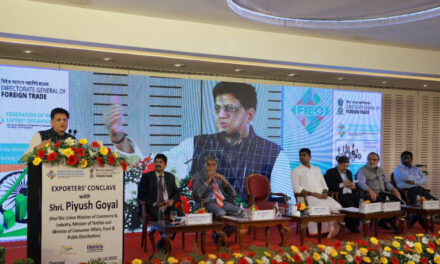 As India celebrates the 10th anniversary of the Make in India initiative, the Apparel, Made-Ups & Home Furnishing Sector Skill Council (AMHSSC) reflects on the profound impact of this flagship program on the country’s textile and apparel industry. Under the visionary leadership of Prime Minister Narendra Modi, Make in India has transformed India into a global manufacturing hub, fostering economic growth, employment generation, and innovation across various sectors. The AMHSSC, a pivotal player in this journey, has been dedicated to skilling the workforce to meet the rising demands of the growing apparel sector.
As India celebrates the 10th anniversary of the Make in India initiative, the Apparel, Made-Ups & Home Furnishing Sector Skill Council (AMHSSC) reflects on the profound impact of this flagship program on the country’s textile and apparel industry. Under the visionary leadership of Prime Minister Narendra Modi, Make in India has transformed India into a global manufacturing hub, fostering economic growth, employment generation, and innovation across various sectors. The AMHSSC, a pivotal player in this journey, has been dedicated to skilling the workforce to meet the rising demands of the growing apparel sector.
Padma Shri Dr. A. Sakthivel, Chairman of AMHSSC, emphasized the importance of this initiative, stating, “Make in India has been instrumental in positioning India as a competitive player in the global apparel and textile market. By focusing on boosting domestic manufacturing, attracting foreign investment, and enhancing infrastructure, this initiative has opened new opportunities for millions in the sector. At AMHSSC, we are committed to equipping the workforce with the skills required to meet industry demands and drive growth in the sector.”
The Role of Make in India in Strengthening the Apparel Sector
The Indian apparel industry has been one of the primary beneficiaries of the Make in India initiative, contributing significantly to job creation and export growth. With the government’s focus on improving manufacturing infrastructure, reducing regulatory barriers, and introducing favorable trade policies, India has become a preferred destination for apparel production. As a result, the sector has witnessed a surge in exports and enhanced its global competitiveness.
India’s Rise to Self-Sufficiency
India’s journey from being heavily reliant on imports, particularly from China, to becoming a self-sufficient manufacturing powerhouse is a significant milestone in its economic transformation. Before 2014, India imported 80% of its mobile phones, however, through initiatives like Make in India and the Production-Linked Incentive (PLI) scheme, India has shifted to local production, now manufacturing 97% of its mobile phone demand domestically. This transition has led to a surge in mobile phone exports, with India achieving a record $15.6 billion in smartphone exports in 2024, marking a 42% year-on-year growth. This broader move towards self-reliance has enabled India to reduce its dependency on imports, and has boosted its exports across multiple sectors, positioning India as a rising global manufacturing hub, driving economic growth and job creation.
Skilling the Workforce for the Future
To meet the growing demand for skilled professionals in the apparel industry, AMHSSC, under the Ministry of Skill Development & Entrepreneurship (MSDE), has played a critical role in providing vocational training and certification programs. Over the last decade, the council has trained over 1.5 million individuals, aligning with the goals of Skill India and Make in India. These programs have ensured a steady supply of skilled labor to drive productivity and innovation in the sector.
“With the rapid changes in fashion trends and the increasing demand for sustainable production, it is crucial to have a workforce that is not only technically skilled but also adaptable to new technologies and practices,” Padma Shri Dr. Sakthivel said. “AMHSSC’s focus on upskilling and reskilling has ensured that the Indian apparel sector remains competitive on the global stage.”
Future Outlook
Padma Shri Dr. Sakthivel added, “The Make in India initiative has laid a strong foundation for the apparel industry to flourish. As we move forward, the focus will remain on innovation, sustainability, and skilling. Together, we will continue to drive the growth of the Indian apparel industry and strengthen its presence in global markets.”
As India celebrates a decade of the Make in India initiative, the apparel, made-ups, and home furnishing industry stands as a testament to the success of this visionary program. The sector’s sustained growth, driven by skill development, innovation, and increased domestic manufacturing, aligns with the country’s broader goals of self-reliance and global competitiveness.










